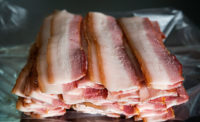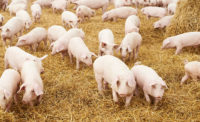Pork continues to be a good value for retailers and consumers. Through early September, 2016 has been a great year for both the fresh and processed pork sales. In fact, this year will once again be a record-breaking pork production year, creating abundant pork supplies through the fourth quarter and early in 2017. Large pork supplies will create strong opportunities for retailers and, ultimately, consumers.
Although both beef and chicken supplies also will increase later this year, the potential pork prices in the meat case will make pork a favorable choice for consumers. For the third and fourth quarters of 2016, many pork promotional opportunities are still available that retailers should explore. With commodity prices beginning to fall, retail prices also will decline if they have not already. Although price deflationary, unlike the other meat protein categories, pork will continue to offer a better gross margin, allowing retailers to buy pork at a value and still be able to sell it at a profit to consumers.
Aggressive price points and a higher increase in weekly pork features are key for retailer success this fall. Undoubtedly, there are abundant levels of meat headed to the supermarkets, but pork will be the best economic choice for retailers to feature due to favorable gross margin returns. Also, the upcoming holiday season is traditionally won by the pork category.
Pork’s versatility, great flavor and price are key attributes for retailers to feature at the meat case and in print promotions this year. Pork is a great option, offering consumers a good value for everyday meals.
Pork is the real winner during the holidays, not only in taste, but also in sales dollars and volume for retailers. Last year alone, ham was No. 1 in sales, with more than 260 million pounds of hams sold, generating more than half the pounds sold in meat and sales dollars than turkey during the fourth-quarter holiday time period. Pork roasts were up 16.6 percent in volume in the fourth quarter of 2015, with sales topping the sales of comparable beef cuts during the holidays.
To continue this success in the fourth quarter of this year, retailers should focus on the fresh pork category and consider featuring pork shoulders, loins and hams for the remainder of 2016. The cuts will bring the best value to retailers and will help move a significant volume of pork during a time of growing supplies.
Looking deeper at hams, the No. 1 selling protein for the holidays, new merchandising options may be the key to success for retailers looking to increase sales. Earlier this year, the National Pork Board conducted ham innovation research to look at how to merchandise ham. The findings defined new flavor profiles, assessed the size of the end product and ways to feature pork. Innovation in ham merchandising will result in consumers being offered more choices for their Thanksgiving and Christmas holiday meal planning.
For example, one leading retailer is introducing smaller portions of ham in addition to whole hams this year. The smaller portions will meet the needs of smaller households and those of Millennial shoppers, helping to introduce ham to a segment of consumers that may have never considered purchasing it before.
For mid-tier consumers, pork loins are a great premium cut option. From the rack of pork to the boneless roast, the pork loin offers retailers versatility in merchandising. The abundant supply of pork will position the loin with consumers and retailers as a value product.
For value-based shoppers, shoulder roasts are ideal. Using slow cookers, preparing pork makes for an easy weeknight meal or a weekend potluck party.
The National Pork Board works closely with retailers to educate consumers on the correct cooking temperature, the names of pork cuts and the importance of quality attributes such as color and marbling. Pork Checkoff consumer research has consistently shown Americans need to better understand how to prepare common cuts of pork to avoid overcooking, leading to a less-than-optimal eating experience. Shoppers who cook it properly return to buy more pork.
The National Pork Board works closely with both retailers and consumers in marketing and educational materials to promote a cooking temperature range of 145 degrees Fahrenheit (medium-rare) to 160 degrees Fahrenheit (well-done), followed by a three-minute rest for pork whole-muscle cuts such as loin, chops and roasts. Ground pork, like all ground meat, should be cooked to 160 degrees Fahrenheit. The lower cooking temperature, approved by the USDA in 2011, encourages consumers to have confidence in consuming pork at a lower temperature. Based on consumer research, the lower temperature range has improved consumers’ taste preferences for pork and has encouraged repeat purchases.
Besides encouraging retailers to educate consumers on the lower cooking temperatures, the National Pork Board has been working with retailers across the nation to implement the 2013 pork nomenclature changes. The simplified meat names were approved for both pork and beef cuts to help consumers make more educated decisions at the meat case. The new names also match those already used by foodservice. The new naming convention has been a positive change for the industry with strong consumer support.
The National Pork Board, in conjunction with retailers, is addressing the need for consistent, high-quality pork products in the meat case and service case. An opportunity exists for the U.S. pork industry to enhance the product quality by improving genetics and working with packers and processors to develop a tiered pork quality standard, similar to beef. Consumer research has proven that consumers look for choice and would respond positively to a new quality system for pork.
In a year of high supply and lower prices, retailer success is critical to the pork industry. The National Pork Board looks forward to working with its retailer partners to implement the tools needed to strengthen consumer demand and growth in pork sales. NP
State of the Industry 2016 segments
| Industry overview | Goes live Oct. 14 |
| Beef (CAB) | Oct. 18 |
| Beef (NCBA) | Oct. 19 |
| Pork (Pork Board) | Oct. 20 |
| Pork (Sun Trust) | Oct. 21 |
| Chicken | Oct. 24 |
| Turkey | Oct. 25 |
| Veal | Oct. 26 |
| Lamb | Oct. 27 |
| Food Safety | Oct. 28 |
| Packaging | Oct. 31 |




